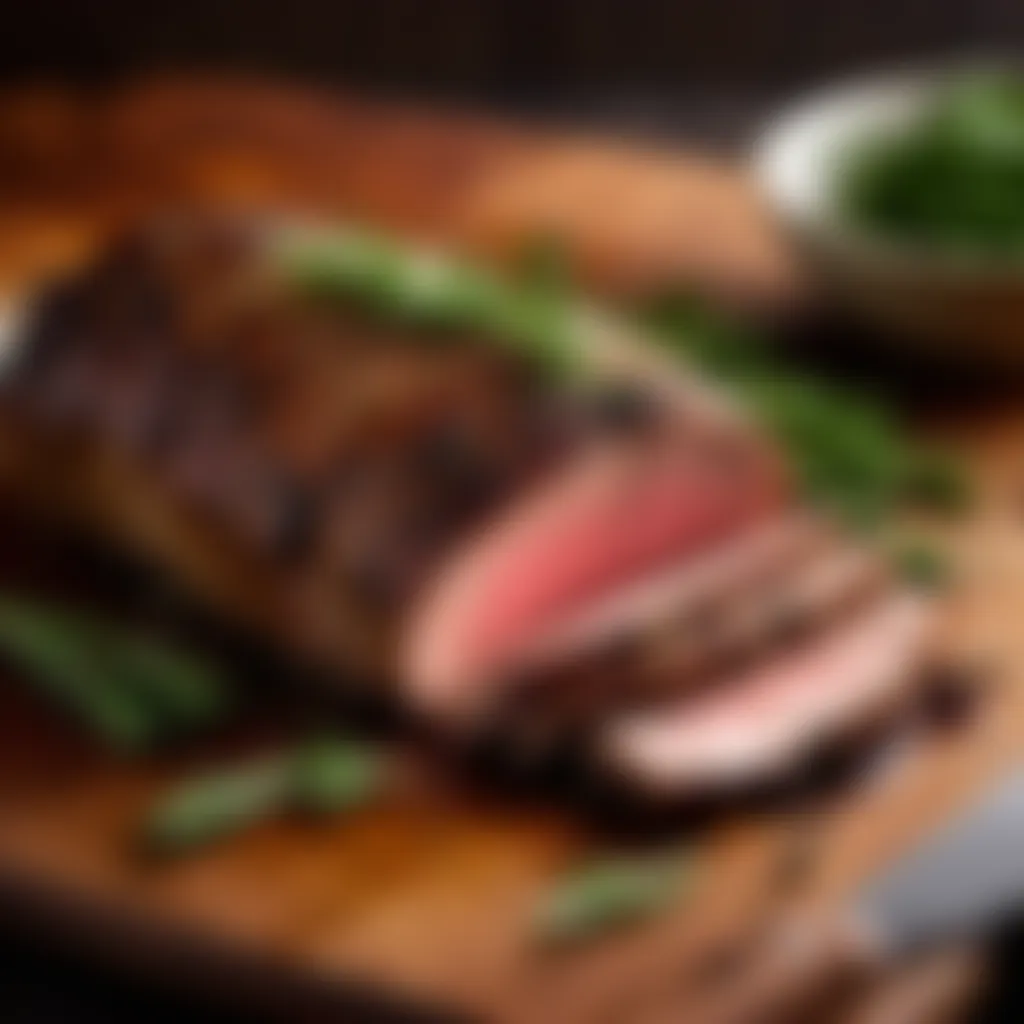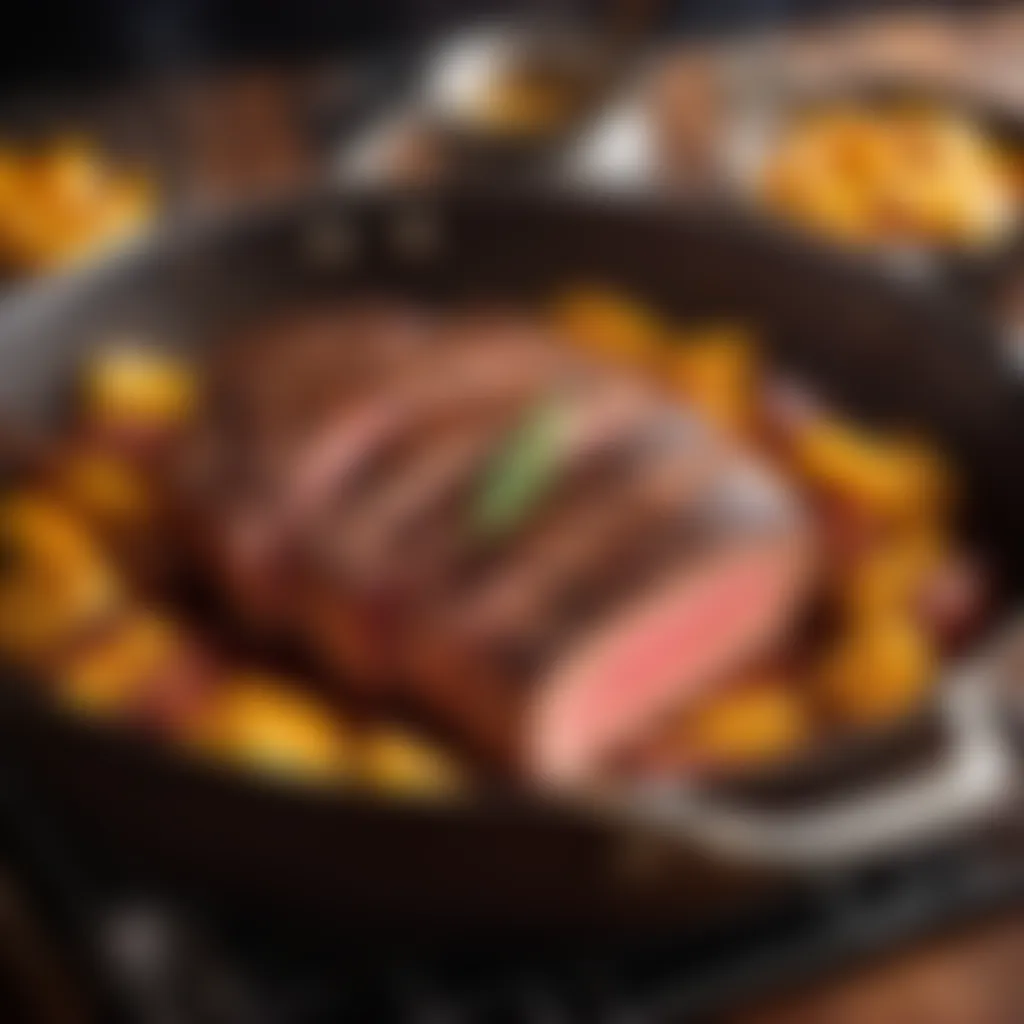Mastering Oven Slow Cooking: Perfect Tri-Tip Recipe


Intro
Cooking tri-tip in the oven can be a delightful venture for home chefs looking to impress their family or simply enjoy a good meal. The key lies in understanding the cut, the cooking process, and the magic of low-and-slow preparation. Often overlooked, tri-tip is a juicy, flavorful cut of beef that, when cooked properly, can turn a simple dinner into a memorable feast.
Leave behind the hurried, high-heat methods; by embracing the slow cooking technique, you unlock flavors that develop over time. It’s not just about getting it done; it’s about savoring each step. By the end of this guide, you’ll be equipped to coax the utmost goodness out of this beef cut, leading to a tender, mouth-watering creation.
Let’s roll up our sleeves and dive into the specifics. We'll start with what you need – the very foundation of great cooking.
Ingredients:
To create that succulent tri-tip, it's imperative to gather the right ingredients. Here's your list of what you'll need to set the stage for perfection:
- Tri-tip roast: 2 to 3 pounds
- Kosher salt: 2 tablespoons
- Black pepper: 1 tablespoon
- Garlic powder: 1 teaspoon
- Onion powder: 1 teaspoon
- Paprika: 1 teaspoon
- Dried rosemary (crushed): 1 teaspoon
- Olive oil: 2 tablespoons
- Beef broth: 1 cup (or red wine for a richer flavor)
- Fresh thyme (optional): 2 sprigs
Here’s a handy tip: Always select fresh ingredients whenever possible. They make a noticeable difference in taste.
Now that we have our ingredients figured out, let’s move on to preparing them.
Preparation Steps:
Once you have your ingredients, preparation is key. Here’s how to get started:
- Marinate the tri-tip:
- Preparing the oven:
- Searing (optional but recommended):
- Braising:
- Adding herbs:
- Begin by patting the tri-tip dry with paper towels. This step is crucial; moisture will inhibit browning.
- In a small bowl, mix the kosher salt, black pepper, garlic powder, onion powder, paprika, and crushed rosemary.
- Rub the spice mix all over the meat, ensuring even coverage. It’s almost therapeutic to let your hands work the spices in.
- Drizzle the olive oil over the roast to help the seasoning adhere. Cover with plastic wrap and place in the fridge for at least one hour, or up to overnight for deeper flavor penetration.
- Preheat your oven to a low setting of 225°F (approximately 107°C). This gentle heat helps break down the tough fibers in the meat, allowing flavors to meld.
- After marinating, you may opt to sear your tri-tip. Heat a cast-iron skillet over medium-high heat. Once hot, add a little olive oil, then place the tri-tip in. Sear each side for about 4-5 minutes, creating a beautiful crust.
- Transfer the seared tri-tip to a roasting pan. Pour the beef broth or red wine into the pan, ensuring it covers the bottom but doesn’t drench the top of the meat. The liquid is essential for moisture during cooking, helping to create a rich sauce.
- If using, throw in a couple of sprigs of fresh thyme for added aroma.
This preparation sets a solid foundation for the cooking process. Let’s explore the technical aspects before moving on to the cooking steps.
Technical Aspects:
Understanding temperature and timing is paramount when it comes to cooking tri-tip. Here's what you need to keep in mind:
- Oven temperature: Maintain the steady low heat of 225°F (107°C) throughout cooking.
- Internal temperature for doneness: Target for medium-rare at around 135°F (57°C), medium at 145°F (63°C), or well-done at 160°F (71°C).
- Timing specifics: Expect cooking to take around 2-3 hours depending on the size of your tri-tip and your desired doneness. A meat thermometer comes handy here, ensuring precision.
Be sure to familiarize yourself with these technicalities, as they are vital to ensuring the best results.
Important: Always let the meat rest for at least 15 minutes post-cooking. This allows juices to redistribute, preventing a dry bite.
With preparation and technical aspects sorted out, we can now dive into the cooking process!


Prelims to Slow Cooking
Slow cooking isn’t just a method; it’s an art form that transforms everyday ingredients into culinary masterpieces. At the heart of this technique lies the ability to patiently coax flavors out of meats and vegetables, resulting in dishes that sing in harmony rather than clash with one another. In this article, we will focus on one of the most delightful cuts of meat you can slow cook—tri-tip. By understanding and embracing slow cooking, you’re opening a door to a world of flavors and textures that will elevate your dining experience.
Understanding Cooking Methods
Knowing various cooking methods is fundamental for any home chef. Each technique provides its own touch to the dish, enhancing certain flavors while downplaying others. Slow cooking utilizes low temperatures over a prolonged period, allowing for even heat distribution. It breaks down tough meat fibers and thick cuts like tri-tip, converting them into soft, succulent bites. This is different from quick cooking methods such as frying or grilling, which might leave the meat chewy and tough if not done right. Think of a slow cooker as a warm hug for your ingredients, wrapping them in soothing heat until they are tender and full of flavor.
Some common methods include:
- Roasting: This method uses dry heat and can produce crispy skins and caramelized surface sugars. However, it typically requires careful temperature control to avoid dryness.
- Braising: Combining both wet and dry cooking methods, braising starts by searing and then finishes with a moist heat. This technique is great for enhancing flavors but requires a fair amount of attention.
- Stewing: Similar to braising, stewing involves cooking small, uniform pieces of food in liquid for a long time. This creates rich, thick sauces but requires more liquid than braising.
In contrast, slow cooking focuses on the essence of the ingredients themselves with minimal interference, allowing flavors to meld beautifully. Understanding these methods can give you a robust foundation on which to build your cooking repertoire.
Benefits of Slow Cooking
Slow cooking offers a bounty of benefits that extend beyond merely preparing food. One of the prime advantages is convenience. Once everything is set in the slow cooker or oven, the bulk of the work is done. You can go about your day while the meal simmers away, absorbing the flavors.
Another major perk is the flavor. Combining various herbs and spices over hours allows the flavors to marry beautifully, creating depth you just can’t achieve with quick cooking. Plus, the low, slow heat brings out the natural sweetness in vegetables and the savory richness of meats. You might find that inexpensive cuts of meat shine in slow-cooked dishes, transforming humble ingredients into something extraordinary.
"Slow cooking gives busy home-cooks a break, turning meal prep into a hands-off endeavor."
The process also promises a healthier meal. By controlling the ingredients and omitting extra oils, you can create wholesome dishes without compromising on taste. Additionally, slow cooking makes dishes more forgiving; you don’t have to watch a pot constantly. Just keep an eye on your oven temperature and timing, and you’re good.
Overview of Tri-Tip Cut
Cooking does not simply hinge on the art of flavor; it deeply intertwines with knowledge of the cuts of meat available, which brings us to an often overlooked but remarkable choice: the tri-tip. Understanding the intricacies of this cut set the stage for elevating your culinary experience, particularly when it comes to slow cooking in the oven. The tri-tip is a unique and flavorful cut of beef that, when prepared correctly, can yield incredibly tender results. With the right guidance, this relatively affordable piece of meat can become the star of your family feasts.
Origins and Characteristics
The tri-tip, a cut that hails primarily from the bottom sirloin, is recognized for its triangular shape, hence its name. Originating back to California in the 1950s, it has gained popularity due in part to its blend of flavor and tenderness. "Tri-tip" is not just a catchy term; it reflects the cut's lineage and geography, which adds a layer of narrative that transforms your dish from ordinary to rich with history.
Its marbling is often the talk of the table. Fat interspersed within the meat enhances juiciness and flavor, making each bite a delight. Moreover, it is versatile. You can prepare it with various cooking methods, but slow cooking showcases its potential brilliantly by breaking down the fat and connective tissues slowly. This results in a melt-in-your-mouth texture that delights your taste buds and fills your kitchen with an inviting aroma.
Selecting the Right Tri-Tip
When it comes to choosing your tri-tip, not all cuts are created equal. You need to be discerning, as the quality of meat makes a remarkable difference in the outcome of your dish. Here are some considerations:
- Marbling: Look for cuts with good marbling. This fat acts as a natural baster during cooking and will render down to inject flavor.
- Color: Opt for a vivid red hue without excessive browning or discoloration. Freshness is key!
- Size: Tri-tips typically weigh between two to five pounds. A cut around three pounds is ideal for family gatherings.
- Source: Consider purchasing from a butcher shop where cuts can be sourced and inspected with care instead of mass-produced supermarket options.
By giving attention to these specific elements, you set a solid foundation for slow cooking your tri-tip. This thoughtful selection process can profoundly impact the final outcome, ensuring that your dining experience is nothing short of superb.
Preparation Steps for Tri-Tip
Getting the preparation right is crucial when it comes to cooking tri-tip. It acts as a foundation that can significantly influence the flavors and tenderness of the final dish. With a few thoughtful methods and techniques, you can elevate your tri-tip to a whole new level. Let’s dive in to discover how proper preparation can make all the difference when slow-cooking this wonderful cut.
Essential Tools and Equipment


To get started on your tri-tip journey, it’s important to gather the right tools and equipment. While it might seem straightforward, having a well-equipped kitchen can simplify your cooking process immensely:
- Knife Set: A sharp chef's knife is essential not just for slicing the meat, but also for trimming it beforehand. Choice of knife can mean a world of difference, as a dull blade can make a right mess out of your beautiful cut of beef.
- Cutting Board: Look for a sturdy cutting board, ideally made of wood or plastic, that provides ample space for handling the tri-tip without risk of slipping.
- Roasting Pan: This should ideally be large enough to accommodate your tri-tip without crowding. A pan with a rack can be quite useful too, as it allows heat to circulate around the meat.
- Meat Thermometer: Investing in a reliable meat thermometer is non-negotiable. It helps you gauge the internal temperature accurately, ensuring your tri-tip isn't under or overcooked.
- Plastic Wrap: For marinating, you need to enclose the meat well. Plastic wrap helps in keeping the flavors locked in.
Having these tools on hand helps streamline your cooking process, making sure everything goes as smooth as butter.
Marinating Techniques
Marinating your tri-tip can add layers of flavor and enhance its tenderness. A good marinade does wonders as it infuses the meat with delicious flavors. Here’s how to go about it:
- Acidic Component: Choose an acid like vinegar, citrus juice, or even yogurt to help break down proteins, leading to tender meat.
- Oil: This creates a barrier that keeps moisture in, balancing the acidic properties of your marinade. Olive oil or avocado oil works wonderfully.
- Flavorings: Add garlic, herbs, and spices to give your marinade a personal touch. Think outside the box – rosemary, thyme, or even chili powder can create a zesty kick!
To marinate, simply mix your chosen ingredients in a bowl, then apply it evenly over the tri-tip. Wrap it tightly with plastic wrap and let it sit in the fridge for at least a couple of hours. Longer is often better; try marinating overnight!
Seasoning Blends
Seasoning is key when it comes to bringing out the natural flavors of the tri-tip. Using the right blend can transform your meat from everyday to extraordinary:
- Simple Salt and Pepper: Sometimes, the classics are best. A generous sprinkle of salt and freshly cracked pepper can yield a delightful crust when roasted.
- Custom Spice Mixes: Consider creating your own tailored seasoning blend. Combine paprika, garlic powder, onion powder, and some cumin to craft a rub that adds depth and edge.
- Store-Bought Options: If time is not on your side, look into pre-made seasoning blends like Montreal steak seasoning or a good BBQ rub. They often pack an awesome punch while saving you time.
Remember, seasoning is not just about the surface; rub it into every nook and cranny. It’s the assurance that each bite will burst with flavor.
Being mindful of these preparation steps will lay a solid ground for your slow-cooked tri-tip. Engage fully with the process, and the end result will surely delight your taste buds.
Cooking Process in the Oven
Cooking tri-tip in the oven is something of an art form. It's not just about throwing a piece of meat in and hoping for the best; it’s a delicate dance of temperature, time, and technique. This section will walk you through the highlights and subtle nuances of the cooking process, emphasizing why each component is crucial for achieving that mouthwatering, tender tri-tip.
Temperature Control
Understanding Oven Settings
Getting the oven settings right is central to a successful cook. Every oven has its own quirks, meaning the temperatures can often be a tad off from what the dial says. A useful characteristic of understanding these settings lies in recognizing the difference between convection and standard heating. Convection ovens circulate heat more evenly, which can help in browning the tri-tip to perfection.
However, the common choice of a conventional oven is still reliable, especially for slow cooking. While it may not evenly distribute heat, it will provide a consistent and steady cooking environment, pivotal for the slow cooking process. Still, tracking those different settings and how they work can prevent unpleasant surprises towards the end of your cook.
Importance of Consistent Heat
Consistent heat is key in the slow cooking journey of tri-tip. A stable cooking environment helps ensure the meat retains moisture while slowly breaking down the connective tissues, resulting in tenderness. When the heat fluctuates, it can cause the tri-tip to cook unevenly; this could result in a dry or tough texture.
A steady temperature aids in maintaining that famed juicy mouthfeel and flavor. One common error is opening the oven door too frequently—this disrupts the airflow and can lead to temperature drops. In contrast, maintaining a constant heat level creates that coveted crust outside while allowing the inside to become delectably tender.
Timing Considerations
How Long to Cook Tri-Tip
Deciding how long to cook tri-tip is more of an art than a science. Generally speaking, a slow roast at around 225°F to 250°F will take roughly an hour for every pound of meat. This slow pace allows flavors to meld and develop. The magic of slow cooking is all about that gradual assimilation of flavors, making every bite memorable.


Timing can be tricky, though. Too little time could leave your tri-tip undercooked, while too much can dry it out. It’s advisable to use a meat thermometer to monitor doneness, aiming for an internal temperature of about 130°F for medium rare, which is where you’ll find that perfect balance of tenderness and flavor.
Resting Time After Cooking
Never underestimate the resting time after your tri-tip has cooked. Once out of the oven, it’s crucial to let the meat rest for about 15 to 20 minutes. This allows the juices to redistribute throughout, ensuring each slice is moist with flavor. A tempting characteristic about resting is that it doesn’t just impact texture; it enhances flavor too.
Many might overlook this step, but skipping it can mean the difference between a dry meal and one bursting with juicy goodness. Resting is often seen as an unnecessary hurdle but it's, in fact, an essential part of the cooking process. Wait it out, and your efforts will be rewarded when it comes time to serve.
Basting and Moisture Maintenance
Maintaining moisture while tri-tip cooks is vital for achieving delectable results. Basting the meat every so often with its own juices or a marinade can prevent it from drying out. Using a baster or spoon, simply collect the juices pooling at the bottom of the cooking pan and drizzle back over the meat.
A unique benefit here is that it not only keeps the meat moist but also enhances the flavor profile. A well-executed basting creates a crunchy exterior that locks in moistness while allowing those savory flavors to penetrate through.
As the slow cooking unfolds, don’t forget that moisture maintenance ensures you get to enjoy every bite of that hearty, flavorful tri-tip.
Tip: Always keep an eye on the juices during cooking. If they start to get low, consider adding a splash of broth to keep things lively.
By focusing on these elements of the cooking process, you are well on your way to mastering the art of slow-cooked tri-tip. From the nuances of temperature to understanding timing, every detail counts when it comes to creating a culinary masterpiece.
Serving Suggestions and Pairings
When it comes to enjoying a sumptuous meal featuring slow-cooked tri-tip, one can’t overlook the importance of serving suggestions and pairings. The right sides and beverages not only elevate the flavor profile of the dish, but they also enhance the overall dining experience. For the focused home cook, getting this stage right can turn an ordinary dinner into something truly memorable. It’s like dressing up a great outfit; the details matter.
Ideal Side Dishes
To complement the rich flavors of tri-tip, it’s crucial to think about textural balance and seasoning harmony in your side dishes. A well-rounded plate should include a mixture of vibrant, fresh vegetables, creamy elements, and something with a bit of crunch. Here are some noteworthy side dishes:
- Garlic Mashed Potatoes: Creamy and buttery, the texture of mashed potatoes acts as a perfect canvas for any savory juices from the tri-tip. Adding roasted garlic provides an extra layer of depth to the flavor.
- Roasted Seasonal Vegetables: Mix carrots, Brussels sprouts, and cauliflower. Roasting at high temperature caramelizes their natural sugars, resulting in a wonderful sweet and savory contrast to the meat.
- Coleslaw: The crispness and tangy flavor of a well-prepared coleslaw can cut through the richness of the beef, providing a refreshing crunch.
- Baked Beans: Sweet and smoky beans not only bring a hearty element to your plate but also pair excellently with the smokiness of the tri-tip.
- Cornbread: This options not only brings a bit of home-cooked comfort to the meal but also balances the meal's richness beautifully.
Each of these sides offers a unique taste experience that can either complement or contrast with the robust profiles of the tri-tip. Think about the colors and flavors on the plate – a feast for the eyes as well as for the palate!
Wine and Beverage Pairing
Pairing beverages with your meal can truly accentuate the flavors of each dish. A carefully selected wine or drink can draw out the subtle notes in the beef while also refreshing the palate between bites. Here are some great options:
- Cabernet Sauvignon: A classic choice, the bold tannins and dark fruit flavors of Cabernet complement the heartiness of tri-tip. It’s an age-old pairing that never goes out of style.
- Malbec: This wine offers a slightly softer approach compared to Cabernet, with rich berry flavors and a touch of smokiness that coexist beautifully with the beef’s savory flavors.
- Zinfandel: For those who fancy a fruit-forward varietal, Zinfandel provides a jammy sweetness and hints of spice that can enhance the caramelized crust of a well-seared tri-tip.
- Bourbon Cocktail: An interesting alternative can be a refreshing bourbon drink mixed with ginger ale or soda. The sweetness of bourbon combined with the spice from ginger can balance and round out the meal nicely.
- Craft Beer: If wine isn't your thing, a rich stout or a pale ale might just do the trick. These styles add additional depth and flavors that pair well with hearty dishes like slow-cooked tri-tip.
Ultimately, the goal for serving suggestions and pairings is to create a seamless experience. Choosing the right options will not only showcase your culinary skills but also satisfy the palette. Remember, it’s all about balance; a thoughtful combination can turn a simple meal into a culinary delight that lingers in memory long after the last bite.
Finale and Final Thoughts
As we wrap up our exploration of slow-cooking tri-tip, it's clear that this culinary technique isn't just about the act of cooking. It transcends beyond merely tossing a piece of meat into the oven. Instead, it embodies a harmonious blend of understanding, patience, and a sprinkle of creativity. Mastering this approach to tri-tip can bring numerous benefits, making it a worthy addition to any home cook's repertoire.
Reflecting on the Process
Reflecting on the slow-cooking process is essential. It offers an opportunity to appreciate the intricacies involved in creating a dish that tantalizes the taste buds. Each step, from selecting a prime cut to the careful marinating and seasoning, plays a vital role in determining the final outcome. As the meat slowly roasts, the aroma wafts through the kitchen, bringing a sense of anticipation and excitement. It's not merely about dinner; it's an experience, a chance to connect with traditions and flavors.
Consider how the tri-tip transforms in the oven. If we were to skip steps or rush the cooking, we would lose those tender textures and rich flavors that slow cooking is renowned for. Think of the patience needed, allowing time for the meat to absorb the seasonings and become tender. Reflecting on this process reinforces the dedication and artistry involved in cooking.
Encouragement to Experiment
Don’t just take the recipe at face value; exploring new flavor profiles can lead to delightful surprises! If you find comfort in a classic garlic and rosemary blend, why not try adding a touch of smoked paprika or a hint of brown sugar next time? Every cook has their signature touch that transforms an ordinary meal into something extraordinary. Experimenting with sides also opens a world of possibilities. From savory roasted vegetables to creamy polenta, the right pairing can elevate your dish.
Try different cooking times or even temperature variations. It may sound simplistic, but the back-and-forth of adjusting your method and observing the results can be enlightening. One meal can inspire ideas for the next, leading to a culinary journey that’s as creative as it is delicious.







